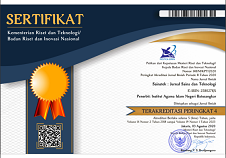ANALISIS POLA KELUARAN PROTOTIPE SENSOR RASA PORTABLE CAMPURAN LIPID DIOCTYL PHOSPHATE DAN TRIOCTYL METHYL AMMONIUM CHLORIDE
Abstract
Portable taste sensor prototype has been fabricated as two channel ion meter and one types of ion selecting membrane. Two channel ion meter were made for pre development of the taste sensor system or as a electronic tongue wich acted as an multi channel ion meter.ion meter was made using IC op-amp LF412 as its amplifier and microcontroller Atmega8535. meanwhile types of the selecting membrane ion were made using variation: mix of lipid diocthyl phosphate (DOP) and triocthyl methyl ammonium chloride (TOMA) with mass ratio respectively 3:7 and 9:1. On this sensor, lipid determines membrane selectivity to particular ions. Output from taste sensor is a electric potential and then it could be compared with electrode potential references. This portable taste sensor prototype is then tested is ability to sensing for 5 types of solution: glucose, KCl, HCl, quinine, and MSG. Those 5 types represent 5 basic taste: sweet by glucose, salty by KCL, sour by HCl, bitter by quinine, and umami by MSG. Every solution is made using 1mM KCl solution and it is variated to be 7 types of concentration. As a result, taste sensor with lipid membrane mixture of 3:7 mixing tend to respon to the anions sample, resulting potential which decreased for every increase in concentration. For membrane with a lipid mixture of 9:1 showed a tendency to respond to the cations sample, resulting potential which increased for every increase in concentration.
Key words: taste sensor, ion meter, ion selecting membrane, lipid, diocthyl phosphate, methyl ammonium chloride.References
Deng S, Tian S dan Chen ZX. 2008. Multifrequency large amplitude pulse voltammetry: a novel electrochemical method for electronic tongue, Sensor and Actuators B 123, 1049-1056.
Habara M, Toko K dan Ikezaki H. 2003. Study Of sweet taste evaluation using taste sensor with lipid/polymer membranes, Biosensors and Bioelectronics, 1559-1563.
Ivarsson P, Hojer N, Holmin S, Krantz-Rulcker C dan Winguist F. 2001. Discrimination of tea by means of a voltammetric electronic tongue and different applied waveforms, Sensor and Actuator B, 449-454.
Kaltsum U, Triyana K dan Siswanta D. 2009. Fabrication and Characterization of Membrane Based on Taste Sensor to Classify Five Types of Basic Taste, Proc, ISSTEC 2009, 301.
Soderstrom C, Winguist F dan Krantz-Rulcker C. 2003. Recognition of Six Microbial Species with an Electronic Tongue, Sens. Actuators B (Chem.) B89 (3), 248-255.
Toko K, Imamura T, Yanagizawa S dan Kume T. 1996. Monitoring of Fermentation Process of Miso (soybean paste) using multichannel taste sensor, Sensor and Actuators B 37, 179-185.
Winguist F, Wide P dan Lundstorm I. 1997. An electronic tongue based on voltametry, Anal. Chim, Acta 375, 21-31.
Winguist F, Bjorklund R, Krantz-Rulcker C, Lundstroma I, Stergren K dan Skoglund T. 2005. An Electronic Tongue in the Dairy Industry, Sensors and Actuators B 111-112, 299-304.
Zheng J dan Melissa P. 2006. Taste Masking Analysis in Pharmaceutical Formulation Development Using an Electronic Tongue, International Journal of Pharmaceutics, 310, 118-124.
DOI: http://dx.doi.org/10.31958/js.v8i1.436
Refbacks
- There are currently no refbacks.
Copyright (c) 2017 Finta Amalinda

This work is licensed under a Creative Commons Attribution-NonCommercial-NoDerivatives 4.0 International License.
Indexed by:
__________________________________________________________________________
Sainstek: Jurnal Sains dan Teknologi
ISSN 2085-8019 (print) | 2580-278x (online)
Published by Institut Agama Islam Negeri Batusangkar
Email: sainstek@iainbatusangkar.ac.id
This work is licensed under a Creative Commons Attribution-NonCommercial-NoDerivatives 4.0 International License.















